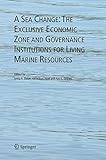A Sea Change: The Exclusive Economic Zone and Governance Institutions for Living Marine Resources / edited by Syma A. Ebbin, Alf Håkon Hoel, Are K. Sydnes.
Tipo de material: TextoEditor: Dordrecht : Springer Netherlands, 2005Descripción: xiv, 223 páginas recurso en líneaTipo de contenido:
TextoEditor: Dordrecht : Springer Netherlands, 2005Descripción: xiv, 223 páginas recurso en líneaTipo de contenido: - texto
- computadora
- recurso en línea
- 9781402031335
- HC79.E5
Springer eBooks
Overview -- Ocean Governance and Institutional Change -- A Brief Introduction to the Principal Provisions of the International Legal Regime Governing Fisheries in the EEZ -- National Strategies for EEZ Implementation -- The Performance of Exclusive Economic Zones -- Fisheries Management in the Russian Federation -- Integrated Oceans Management and the Institutional Performance of Exclusive Economic Zones -- The Impact of the EEZ on Pacific Salmon Management -- Regulating Access and the Use of Marine Genetic Resources within the Exclusive Economic Zone -- Regional Strategies for Coordinating the EEZ Regime -- Regional Fisheries Organisations and International Fisheries Governance -- Exclusive Economic Zones and the Management of Fisheries in the South China Sea -- Staking Their Claims: The Management of Marine Resources in the Exclusive Economic Zones of the Pacific Islands -- A Changing Sea: New and Emerging Institutional Directions for the EEZ -- FAO’S Fisheries Programme and the Plan of Implementation of the World Summit on Sustainable Development -- Governing the Bering Sea Region -- Changing Seas, Changing Institutions: Charting New Courses into the Future.
The establishment of 200-mile Exclusive Economic Zones (EEZs) constitutes one of the most far-reaching distributional and institutional changes in the history of the world. They brought over 20 % of the world’s oceans, a substantial proportion of its productivity, and 90 to 95 % of world fisheries under the national jurisdiction of coastal states. At this time, 145 states have ratified the Law of the Sea Convention and most have established EEZs. Some have established only a legal framework, while other countries have elaborated EEZ regimes. This volume focuses on the specific nature of the EEZ and the construction and evolution of institutions stemming from its introduction, specifically examining developments at local, national and international levels. The broad range of contributions by the authors highlights the diversity of institutions and outcomes that have emerged from the implementation of the EEZs, providing a rich opportunity for comparative analysis.
Para consulta fuera de la UANL se requiere clave de acceso remoto.


